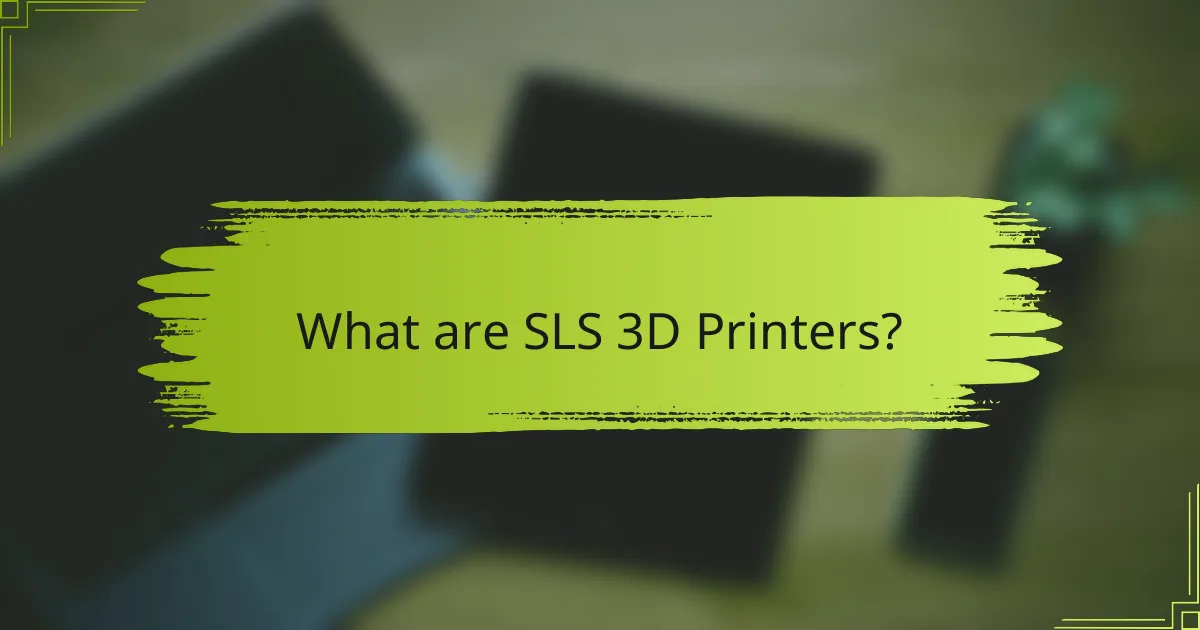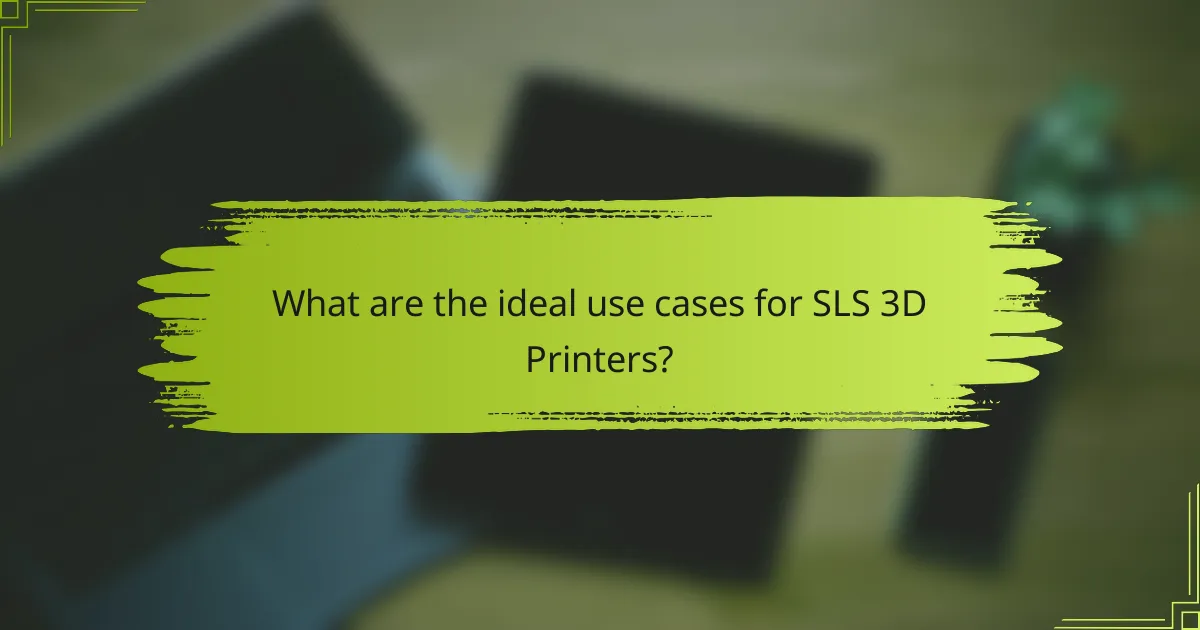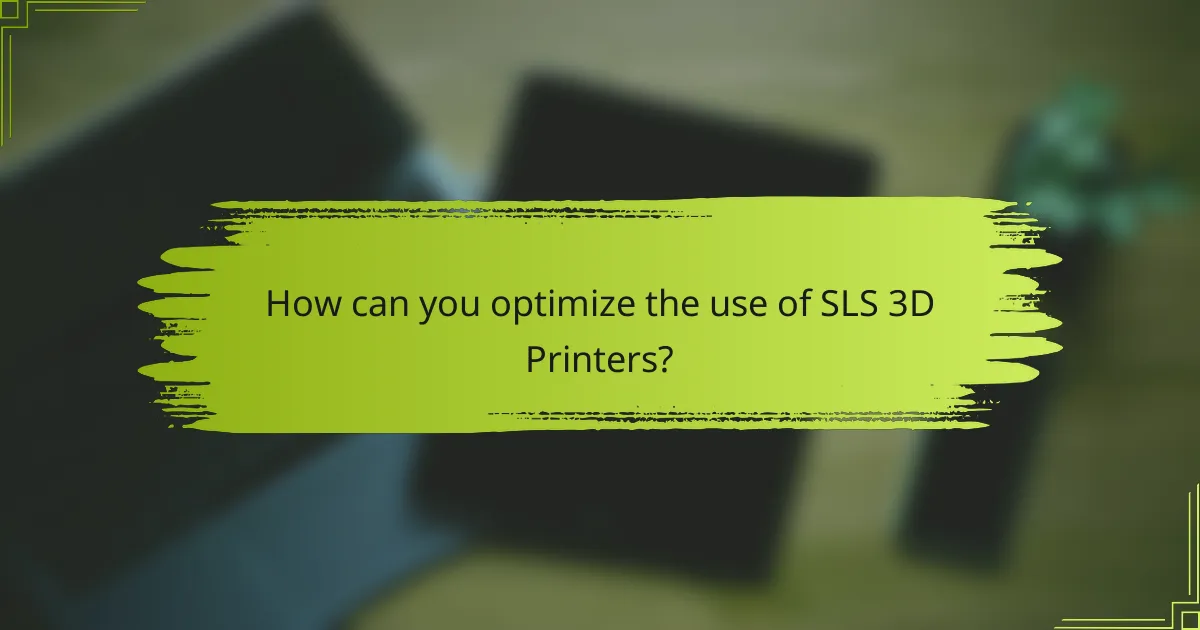
What are SLS 3D Printers?
SLS 3D printers, or Selective Laser Sintering printers, are additive manufacturing machines that use a laser to fuse powdered materials. They create solid objects layer by layer from a digital file. The process involves heating the powder just below its melting point. A laser selectively sinters the powder, binding it together to form a solid structure. SLS printers can work with various materials, including plastics and metals. They are known for producing complex geometries and high-strength parts. This technology is widely used in industries such as aerospace, automotive, and medical. SLS 3D printing offers advantages like minimal waste and the ability to create intricate designs.
How do SLS 3D Printers function?
SLS 3D printers function by using a laser to fuse powdered material into solid objects. The process begins with a layer of powder spread evenly across the build platform. A high-powered laser then selectively scans the powder surface, melting it according to the 3D model’s design. Once the laser completes a layer, the build platform lowers, and a new layer of powder is applied. This process repeats until the entire object is completed. SLS technology typically uses materials like nylon or polymers, which are known for their strength and durability. The result is a highly detailed and robust final product, suitable for various applications in industries such as aerospace and automotive.
What materials are used in SLS 3D printing?
SLS 3D printing primarily uses powdered materials. Common materials include nylon, also known as polyamide, which offers strength and flexibility. Other materials are polystyrene, which is lightweight and easy to process, and metal powders like stainless steel for durable parts. These materials can be mixed with additives to enhance properties. The powdered form allows for precise layer-by-layer construction. SLS technology utilizes a laser to fuse the powder, creating solid structures. This method is effective for producing complex geometries and functional prototypes.
What is the process of creating an SLS 3D printed object?
The process of creating an SLS 3D printed object involves several key steps. First, a 3D model is designed using CAD software. This model is then sliced into thin layers using slicing software. Next, a layer of powdered material, typically nylon or other polymers, is spread evenly across the build platform. A laser then selectively fuses the powder according to the sliced model’s specifications. After one layer is completed, the build platform lowers slightly, and another layer of powder is applied. This process repeats until the entire object is completed. Finally, the excess powder is removed, revealing the finished part. This method allows for complex geometries and high precision in the final product.
What are the advantages of using SLS 3D Printers?
SLS 3D printers offer several advantages. They produce complex geometries that traditional manufacturing methods cannot achieve. SLS technology allows for the creation of functional parts with high accuracy. The process uses powdered materials, which reduces waste compared to other methods. SLS printers can work with a variety of materials, including plastics and metals. They enable rapid prototyping, significantly shortening development times. Parts produced are often stronger and more durable due to the sintering process. SLS is ideal for small production runs, providing cost-effective solutions for custom parts.
How does SLS compare to other 3D printing technologies?
SLS, or Selective Laser Sintering, is distinct from other 3D printing technologies in its use of powdered materials. Unlike FDM, which extrudes thermoplastic filaments, SLS employs a laser to fuse powdered nylon or other materials layer by layer. This process allows for complex geometries and high strength in finished parts. SLS generally produces stronger and more durable parts than SLA, which uses resin and can be more fragile. Furthermore, SLS does not require support structures, unlike FDM and SLA, as the surrounding powder supports the part during printing. This results in less material waste and enables more intricate designs. In terms of production speed, SLS can be faster than both FDM and SLA for larger batches due to its continuous layer processing. Overall, SLS offers unique advantages in strength, design flexibility, and material efficiency compared to other 3D printing methods.
What are the cost benefits associated with SLS 3D printing?
SLS 3D printing offers significant cost benefits. It reduces material waste by using a powder bed process. This method allows excess powder to be reused, minimizing material costs. Production time is also decreased due to faster printing speeds compared to traditional methods. SLS enables the creation of complex geometries, reducing the need for assembly and additional components. This efficiency can lower labor costs associated with production. Furthermore, SLS can produce parts in small batches, making it cost-effective for low-volume manufacturing. These factors combined lead to overall cost savings in the production process.

What are the ideal use cases for SLS 3D Printers?
SLS 3D printers are ideal for producing complex geometries and functional prototypes. They excel in creating parts with intricate designs that traditional manufacturing cannot achieve. SLS technology is particularly suited for low-volume production runs. It allows for rapid iteration and design changes without significant cost increases. Industries such as aerospace benefit from SLS due to lightweight and durable components. Medical applications also leverage SLS for custom implants and surgical tools. The automotive sector uses SLS for producing end-use parts and tooling. SLS printers are effective for creating parts that require high strength and thermal stability.
Which industries utilize SLS 3D printing?
The industries that utilize SLS 3D printing include aerospace, automotive, healthcare, and consumer goods. In aerospace, SLS is used for producing lightweight and complex parts. The automotive industry employs SLS for rapid prototyping and manufacturing of functional components. Healthcare benefits from SLS in creating customized implants and surgical guides. Consumer goods companies use SLS to produce intricate designs and prototypes quickly. Each of these industries leverages SLS technology for its ability to create strong, durable parts efficiently.
How is SLS used in prototyping?
SLS, or Selective Laser Sintering, is used in prototyping by creating parts layer by layer from powdered materials. The process begins with a laser selectively fusing powdered material based on a digital design. This allows for high precision and complex geometries that traditional methods cannot achieve. SLS is particularly effective for functional prototypes, as it produces durable and heat-resistant parts. The technology supports a variety of materials, including nylon and metal powders. Research shows that SLS can reduce lead times significantly in the prototyping phase. It enables rapid iteration and testing of designs, enhancing product development efficiency.
What applications benefit from the durability of SLS printed parts?
Applications that benefit from the durability of SLS printed parts include aerospace, automotive, and medical industries. In aerospace, SLS parts are used for lightweight components that withstand extreme conditions. In the automotive sector, durable SLS parts are utilized for functional prototypes and end-use components. The medical field employs SLS for custom implants and surgical tools that require high strength. The durability of SLS printed parts ensures they can endure rigorous testing and operational demands. This capability is supported by the material properties of SLS, such as high tensile strength and resistance to heat.
What are the limitations of SLS 3D printing?
SLS 3D printing has several limitations. One major limitation is the high cost of equipment and materials. SLS printers are typically more expensive than other 3D printing technologies. The process also requires specialized knowledge to operate effectively. Additionally, SLS printing can produce parts with a rough surface finish. Post-processing steps are often necessary to improve aesthetics. The technology is also limited in terms of material variety compared to other methods. Lastly, SLS prints can exhibit residual stresses, which may affect part performance. These limitations can impact the decision to use SLS for certain applications.
What challenges do users face with SLS technology?
Users face several challenges with SLS technology. One significant challenge is the high cost of SLS printers and materials. This makes initial investment and operational expenses substantial. Another challenge is the complexity of the printing process. Users often require specialized knowledge to operate SLS printers effectively. Additionally, post-processing is necessary for SLS parts, which can be time-consuming and labor-intensive.
Material limitations also exist, as not all materials are suitable for SLS printing. The quality of printed parts can vary, leading to inconsistencies. Furthermore, users may encounter issues with powder handling and safety, as the fine powders can pose health risks. Lastly, the size of the build chamber can restrict the dimensions of the objects being printed. These challenges can hinder the widespread adoption and efficiency of SLS technology.
How can these limitations be addressed?
Limitations of SLS 3D printers can be addressed through several strategies. First, improving powder quality can enhance print accuracy and surface finish. Advanced materials with better flow characteristics can reduce issues related to powder spreading. Second, optimizing the heating elements can minimize thermal inconsistencies during printing. Consistent temperature control leads to better layer adhesion. Third, implementing advanced software algorithms can improve design and support structures. This can streamline the printing process and reduce material waste. Additionally, investing in post-processing techniques can enhance the final product quality. Techniques such as sandblasting or chemical smoothing can improve surface aesthetics. Lastly, user training and education on best practices can reduce operational errors. These strategies collectively improve the performance and reliability of SLS 3D printers.

How can you optimize the use of SLS 3D Printers?
Optimize the use of SLS 3D printers by adjusting parameters like temperature and layer thickness. Properly calibrating the printer ensures accurate material melting and solidification. Use high-quality powder materials to achieve better part density and mechanical properties. Implement effective support structures to minimize warping and improve surface finish. Regular maintenance of the printer enhances performance and reduces downtime. Monitor the build chamber environment to maintain optimal conditions for printing. Employ advanced software for better design and slicing of models. These strategies lead to improved print quality and efficiency in SLS 3D printing.
What best practices should be followed when using SLS 3D Printers?
Use proper material selection for SLS 3D printers. This ensures optimal print quality and mechanical properties. Regularly calibrate the printer to maintain accuracy and precision. Clean the build chamber and components frequently to prevent contamination. Monitor temperature settings closely to ensure consistent melting of the powder. Implement proper support structures to enhance part stability during printing. Utilize a suitable post-processing method to achieve desired surface finish. Follow manufacturer guidelines for maintenance and operation to prolong printer lifespan.
How can you ensure quality in SLS prints?
To ensure quality in SLS prints, maintain optimal powder quality and consistency. Use high-grade nylon or polymer powders designed for SLS. Regularly calibrate the printer to ensure precise temperature and laser settings. Monitor the build chamber environment to prevent contamination and moisture. Implement a thorough post-processing routine to remove excess powder and improve surface finish. According to a study by the University of Cambridge, proper calibration and material selection significantly enhance print fidelity and mechanical properties.
What maintenance tips are crucial for SLS 3D printers?
Regularly clean the build chamber of SLS 3D printers. This prevents contamination of powder and ensures print quality. Inspect the laser optics frequently for dust and debris. Clean optics using appropriate materials to maintain beam quality. Calibrate the printer regularly to ensure accurate layer thickness and dimensional accuracy. Check and replace worn components, such as the recoater blade, to avoid print failures. Monitor the temperature and humidity levels in the printing environment. Maintaining optimal conditions prolongs printer life and improves print results. Conduct routine software updates to ensure efficient operation and access to the latest features.
What troubleshooting steps can help resolve common issues with SLS 3D printing?
To resolve common issues with SLS 3D printing, start by checking the powder quality. Poor quality powder can lead to print failures. Ensure the build chamber is properly calibrated. Calibration affects layer adhesion and print accuracy. Inspect the laser settings for power and speed. Incorrect settings can cause under or over-fusion of layers. Monitor the heating elements for consistent temperature. Inconsistent temperatures can result in warping or incomplete prints. Clean the optics regularly to maintain laser focus. Dirty optics can degrade print quality. Finally, review the design files for errors. Design flaws can lead to structural weaknesses in the printed object.
How can you fix common printing errors in SLS 3D printing?
To fix common printing errors in SLS 3D printing, first ensure proper powder quality. Using high-quality, dry powder prevents issues like poor layer adhesion. Next, calibrate the laser settings accurately. Incorrect laser power or speed can lead to under or over-sintering. Additionally, maintain optimal temperature in the build chamber. Insufficient temperature can cause warping or incomplete fusion. Regularly check the recoater blade for wear. A damaged blade can result in uneven powder distribution. Lastly, perform routine maintenance on the printer components. This ensures consistent performance and reduces the likelihood of errors.
What resources are available for further learning about SLS 3D printing?
Books on SLS 3D printing include “Additive Manufacturing: Materials, Processes, Quantifications and Applications” by A. T. Kearney. Online courses are available from platforms like Coursera and Udemy, focusing on 3D printing technologies. Research papers can be found in journals such as “Additive Manufacturing” and “3D Printing and Additive Manufacturing.” Websites like 3D Printing Industry and All3DP offer articles and guides on SLS technology. Additionally, forums like Reddit and specialized groups on LinkedIn provide community support and discussions.
SLS 3D printers, or Selective Laser Sintering printers, are advanced additive manufacturing machines that utilize a laser to fuse powdered materials into solid objects layer by layer. This article provides a comprehensive overview of SLS technology, detailing its operational process, materials used, advantages, and ideal applications across various industries such as aerospace, automotive, and healthcare. Key topics include the functionality of SLS printers, comparisons with other 3D printing methods, cost benefits, and best practices for optimizing print quality and addressing common challenges. The content aims to equip readers with essential knowledge about SLS 3D printing and its practical implications in modern manufacturing.